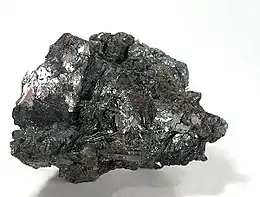Teallite
Teallite is a sulfide mineral of tin and lead with chemical formula: PbSnS2. It occurs in hydrothermal veins and is sometimes mined as an ore of tin. Teallite forms soft silvery grey mica-like plates and crystallizes in the orthorhombic system. The Mohs hardness is 1.5 to 2 and the specific gravity is 6.4.
| Teallite | |
|---|---|
 | |
| General | |
| Category | Sulfide minerals |
| Formula (repeating unit) | PbSnS2 |
| Strunz classification | 2.CD.05 |
| Crystal system | Orthorhombic |
| Crystal class | Dipyramidal (mmm) H-M symbol: (2/m 2/m 2/m) |
| Space group | Pbnm (no. 62) |
| Unit cell | a = 4.26 Å, b = 11.41 Å c = 4.09 Å; Z = 2 |
| Identification | |
| Color | Silvery gray, lead-gray to iron-gray; tarnishes dull or iridescent |
| Cleavage | {001} perfect (lamellar cleavage); flexible |
| Tenacity | Malleable |
| Mohs scale hardness | 1 1⁄2 - 2 |
| Luster | Metallic |
| Streak | Black |
| Diaphaneity | Opaque |
| Specific gravity | 6.36 |
| Optical properties | Anisotropic |
| Pleochroism | Weak |
| References | [1][2] |
Teallite was first described in 1904 from its type locality in Santa Rosa, Antequera, Bolivia. It was named for the British geologist Jethro Justinian Harris Teall (1849–1924).[3]
See also
- Classification of minerals
- List of minerals
- List of minerals named after people
External links
![]() Media related to Teallite at Wikimedia Commons
Media related to Teallite at Wikimedia Commons
This article is issued from Wikipedia. The text is licensed under Creative Commons - Attribution - Sharealike. Additional terms may apply for the media files.
